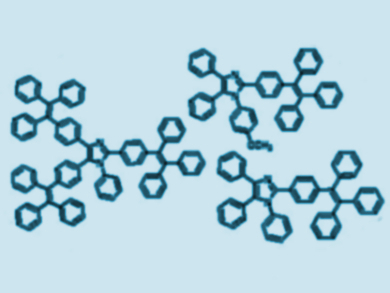Many luminophores show the phenomenon of aggregation-caused quenching (ACQ). Here the intensity of emission decreases in the aggregated form, leading to a reduced organic light emitting device (OLED) efficiency. Luminogenic materials, in contrast, demonstrate a photophysical effect known as aggregation-induced emission (AIE). The emission intensity of these materials decreases when they are dissolved in good solvents, but increases in the aggregate/solid form in poor solvents.
Lian Duan, Tsinghua University, Beijing, China, Ziyi Ge, Ningbo Institute of Materials Technology & Engineering, China, and colleagues have developed AIE emitters based on a simple combination of imidazole and tetraphenylethene (examples pictured). The team prepared 1,4,5-triphenyl-2-(4-(1,2,2-triphenylvinyl)-phenyl)-1H-imidazole (TPEI), 1-(4-methoxyphenyl)-4,5-di-phenyl-2-(4-(1,2,2-triphenylvinyl)phenyl)-1H-imidazole (TPEMeOPhI) and 1-phenyl-2,4,5-tris(4-(1,2,2-triphenylvinyl)phenyl)-1H-imidazole (3TPEI) using condensation reactions.
All of the materials exhibit excellent AIE behavior. Sky-blue OLEDs were fabricated using these emitters and showed efficiencies as high as 3.13 %. These results indicate a potential of AIE materials for OLED applications.
- Non-Doped Sky-Blue OLEDs Based on Simple Structured AIE Emitters with High Efficiencies at Low Driven Voltages,
Amjad Islam, Dongdong Zhang, Ruixiang Peng, Rongjuan Yang, Ling Hong, Wei Song, Qiang Wei, Lian Duan, Ziyi Ge,
Chem. Asian J. 2017.
DOI: 10.1002/asia.201700833




